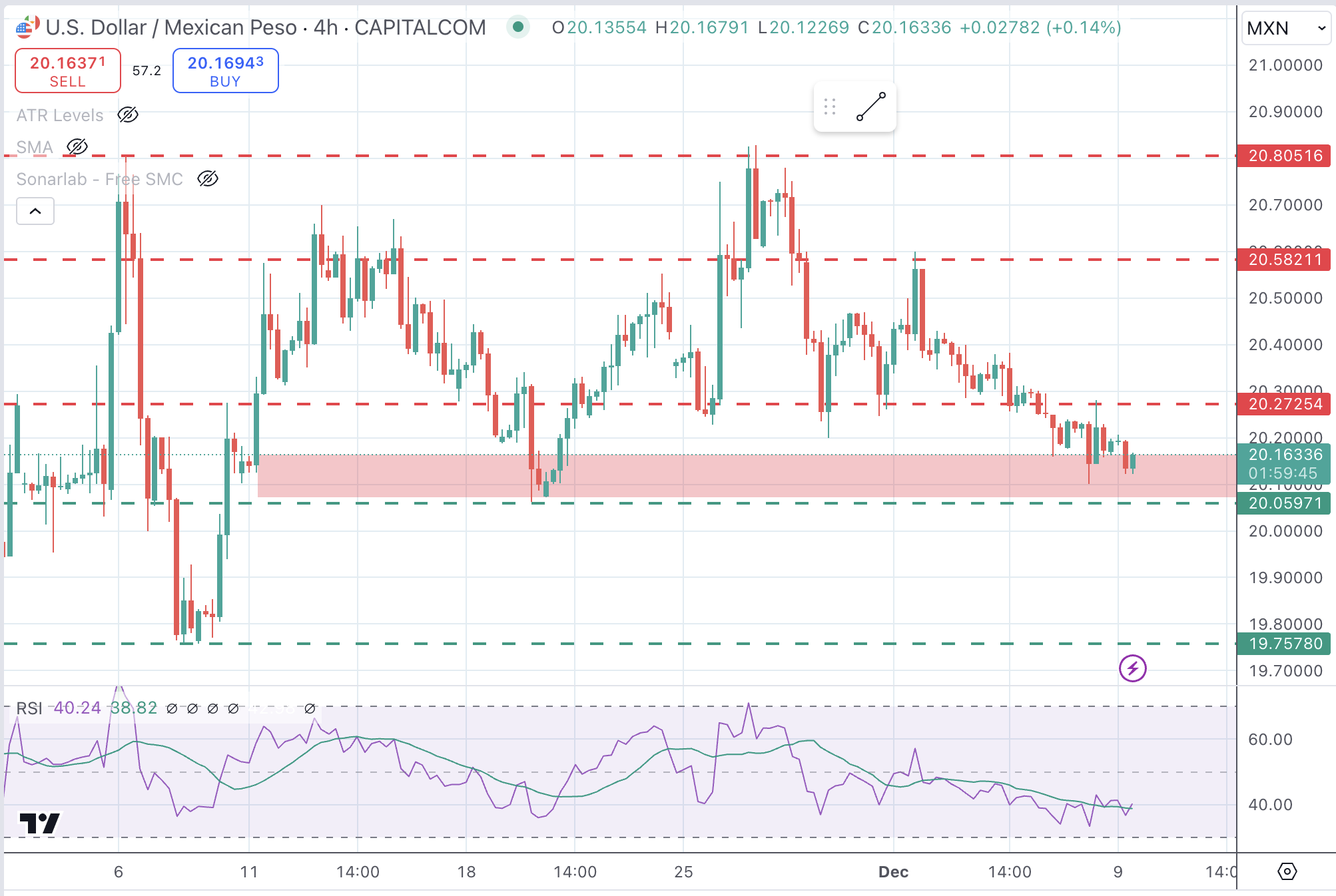Mexican Peso nears 20.00 level against US Dollar ahead of inflation data
- The USD/MXN resumed its downtrend as the effect of the release of strong US labour figures waned.
- Mexican CPI data is expected to show cooling inflation, which might increase the selling pressure on the MXN.
- Technically, USD/MXN’s double top at 20.80 suggests the possibility of a deeper correction.
The Mexican Peso (MXN) opened the week in the same positive tone seen in the previous one, slightly appreciating against the US Dollar. The USD/MXN pair has lost about 3.30% after peaking near 21.00 in late November and is approaching the key 20.00 area ahead of the release of last month’s inflation figures.
The pair’s mild recovery attempt seen on Friday was halted after the dust from the strong US Nonfarm Payrolls (NFP) data settled. The higher unemployment rate increased hopes that the Federal Reserve (Fed) will cut rates again next week.
The US calendar is thin on Monday, and the focus will be on Mexico’s Consumer Prices Index (CPI) figures. Price pressures are expected to have resumed their cooling trend in November after an uptick in October. This might increase hopes of a further rate cut next week by the Banxico and increase pressure on the Peso.
Daily digest market movers: Mexican Peso extends gains despite strong US data
- US Nonfarm payrolls increased by 227,000 in November, beating expectations of a 200,000 increase. October’s data was revised to a 36,000 increment from the previously estimated 12,000 payrolls.
- The US unemployment rate, however, increased to 4.2% from 4.1% in October, which cemented hopes of a Federal Reserve (Fed) cut in December, and kept the US Dollar from rallying further.
- Futures markets are now pricing a nearly 90% chance that the Fed will cut rates by 25 basis points in December, up from below 70% last week, according to data from the CME Group’s Fed Watch tool.
- Later on Monday, Mexico’s inflation is expected to show some cooling, with the yearly CPI easing to 4.59% in November from 4.76% in October. The core CPI is seen down to 3.6% from the previous 3.8% level.
Mexican Peso technical outlook: USD/MXN approaches key support at 20.00
The USD/MXN maintains its negative bias intact from the late November highs at around 20.80. The pair, however, faces a strong support area between 20.05 and 20.15.
The 4-hour Relative Strength Index (RSI) is in bearish territory below the 40 level, and the double top at 20.80 suggests the possibility of a deeper correction.
Below the 20.00 psychological level, which is also the neckline of the mentioned double top, the next target would be November’s low at 19.75. Resistances are Friday’s high at 20.25, ahead of the December 2 high at 20.60 and November’s peak at 20.80.
USD/MXN 4-Hour Chart

Inflation FAQs
Inflation measures the rise in the price of a representative basket of goods and services. Headline inflation is usually expressed as a percentage change on a month-on-month (MoM) and year-on-year (YoY) basis. Core inflation excludes more volatile elements such as food and fuel which can fluctuate because of geopolitical and seasonal factors. Core inflation is the figure economists focus on and is the level targeted by central banks, which are mandated to keep inflation at a manageable level, usually around 2%.
The Consumer Price Index (CPI) measures the change in prices of a basket of goods and services over a period of time. It is usually expressed as a percentage change on a month-on-month (MoM) and year-on-year (YoY) basis. Core CPI is the figure targeted by central banks as it excludes volatile food and fuel inputs. When Core CPI rises above 2% it usually results in higher interest rates and vice versa when it falls below 2%. Since higher interest rates are positive for a currency, higher inflation usually results in a stronger currency. The opposite is true when inflation falls.
Although it may seem counter-intuitive, high inflation in a country pushes up the value of its currency and vice versa for lower inflation. This is because the central bank will normally raise interest rates to combat the higher inflation, which attract more global capital inflows from investors looking for a lucrative place to park their money.
Formerly, Gold was the asset investors turned to in times of high inflation because it preserved its value, and whilst investors will often still buy Gold for its safe-haven properties in times of extreme market turmoil, this is not the case most of the time. This is because when inflation is high, central banks will put up interest rates to combat it. Higher interest rates are negative for Gold because they increase the opportunity-cost of holding Gold vis-a-vis an interest-bearing asset or placing the money in a cash deposit account. On the flipside, lower inflation tends to be positive for Gold as it brings interest rates down, making the bright metal a more viable investment alternative.


